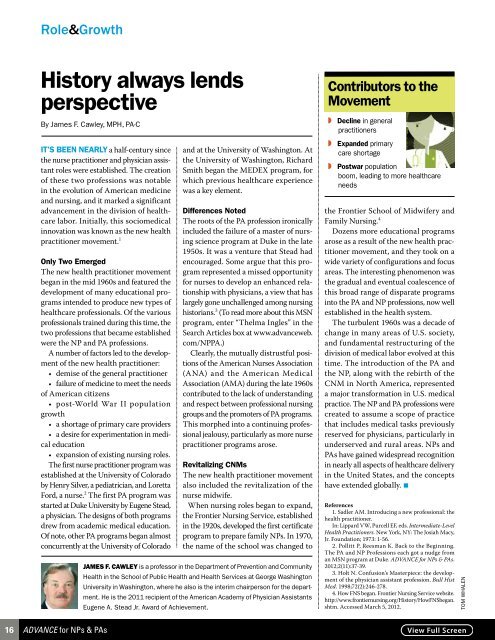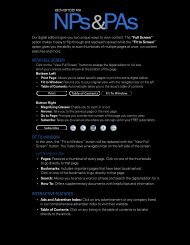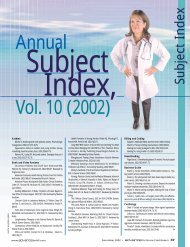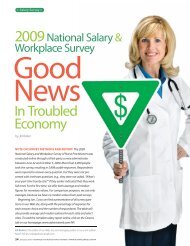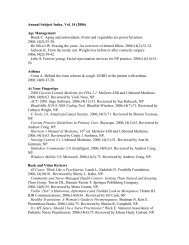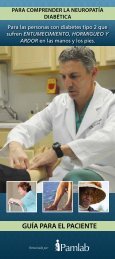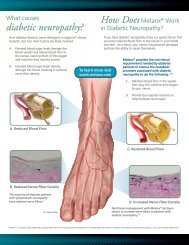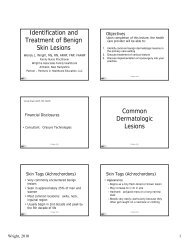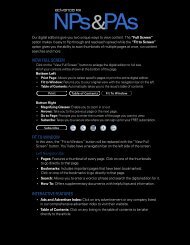Download - ADVANCE for NPs & PAs
Download - ADVANCE for NPs & PAs
Download - ADVANCE for NPs & PAs
- No tags were found...
You also want an ePaper? Increase the reach of your titles
YUMPU automatically turns print PDFs into web optimized ePapers that Google loves.
Role&GrowthHistory always lendsperspectiveBy James F. Cawley, MPH, PA-CIt’s been nearly a half-century sincethe nurse practitioner and physician assistantroles were established. The creationof these two professions was notablein the evolution of American medicineand nursing, and it marked a significantadvancement in the division of healthcarelabor. Initially, this sociomedicalinnovation was known as the new healthpractitioner movement. 1Only Two EmergedThe new health practitioner movementbegan in the mid 1960s and featured thedevelopment of many educational programsintended to produce new types ofhealthcare professionals. Of the variousprofessionals trained during this time, thetwo professions that became establishedwere the NP and PA professions.A number of factors led to the developmentof the new health practitioner:• demise of the general practitioner• failure of medicine to meet the needsof American citizens• post-World War II populationgrowth• a shortage of primary care providers• a desire <strong>for</strong> experimentation in medicaleducation• expansion of existing nursing roles.The first nurse practitioner program wasestablished at the University of Coloradoby Henry Silver, a pediatrician, and LorettaFord, a nurse. 2 The first PA program wasstarted at Duke University by Eugene Stead,a physician. The designs of both programsdrew from academic medical education.Of note, other PA programs began almostconcurrently at the University of Coloradoand at the University of Washington. Atthe University of Washington, RichardSmith began the MEDEX program, <strong>for</strong>which previous healthcare experiencewas a key element.Differences NotedThe roots of the PA profession ironicallyincluded the failure of a master of nursingscience program at Duke in the late1950s. It was a venture that Stead hadencouraged. Some argue that this programrepresented a missed opportunity<strong>for</strong> nurses to develop an enhanced relationshipwith physicians, a view that haslargely gone unchallenged among nursinghistorians. 3 (To read more about this MSNprogram, enter “Thelma Ingles” in theSearch Articles box at www.advanceweb.com/NPPA.)Clearly, the mutually distrustful positionsof the American Nurses Association(ANA) and the American MedicalAssociation (AMA) during the late 1960scontributed to the lack of understandingand respect between professional nursinggroups and the promoters of PA programs.This morphed into a continuing professionaljealousy, particularly as more nursepractitioner programs arose.Revitalizing CNMsThe new health practitioner movementalso included the revitalization of thenurse midwife.When nursing roles began to expand,the Frontier Nursing Service, establishedin the 1920s, developed the first certificateprogram to prepare family <strong>NPs</strong>. In 1970,the name of the school was changed toJames F. Cawley is a professor in the Department of Prevention and CommunityHealth in the School of Public Health and Health Services at George WashingtonUniversity in Washington, where he also is the interim chairperson <strong>for</strong> the department.He is the 2011 recipient of the American Academy of Physician AssistantsEugene A. Stead Jr. Award of Achievement.Contributors to theMovement◗ Decline in generalpractitioners◗ Expanded primarycare shortage◗ Postwar populationboom, leading to more healthcareneedsthe Frontier School of Midwifery andFamily Nursing. 4Dozens more educational programsarose as a result of the new health practitionermovement, and they took on awide variety of configurations and focusareas. The interesting phenomenon wasthe gradual and eventual coalescence ofthis broad range of disparate programsinto the PA and NP professions, now wellestablished in the health system.The turbulent 1960s was a decade ofchange in many areas of U.S. society,and fundamental restructuring of thedivision of medical labor evolved at thistime. The introduction of the PA andthe NP, along with the rebirth of theCNM in North America, representeda major trans<strong>for</strong>mation in U.S. medicalpractice. The NP and PA professions werecreated to assume a scope of practicethat includes medical tasks previouslyreserved <strong>for</strong> physicians, particularly inunderserved and rural areas. <strong>NPs</strong> and<strong>PAs</strong> have gained widespread recognitionin nearly all aspects of healthcare deliveryin the United States, and the conceptshave extended globally. ■References1. Sadler AM. Introducing a new professional: thehealth practitioner.In: Lippard VW, Purcell EF, eds. Intermediate-LevelHealth Practitioners. New York, NY: The Josiah Macy,Jr. Foundation; 1973: 1-56.2. Pollitt P, Reesman K. Back to the Beginning.The PA and NP Professions each got a nudge froman MSN program at Duke. <strong>ADVANCE</strong> <strong>for</strong> <strong>NPs</strong> & <strong>PAs</strong>.2012;2(11):37-39.3. Holt N. Confusion’s Masterpiece: the developmentof the physician assistant profession. Bull HistMed. 1998;72(2):246-278.4. How FNS began. Frontier Nursing Service website.http://www.frontiernursing.org/History/HowFNSbegan.shtm. Accessed March 5, 2012.Tom Whalen16 <strong>ADVANCE</strong> <strong>for</strong> <strong>NPs</strong> & <strong>PAs</strong>


